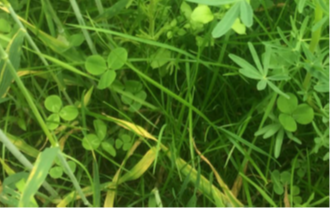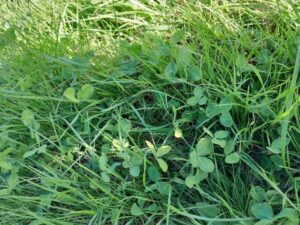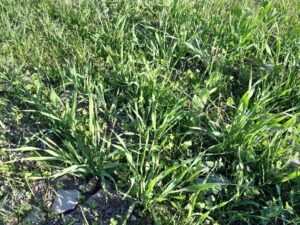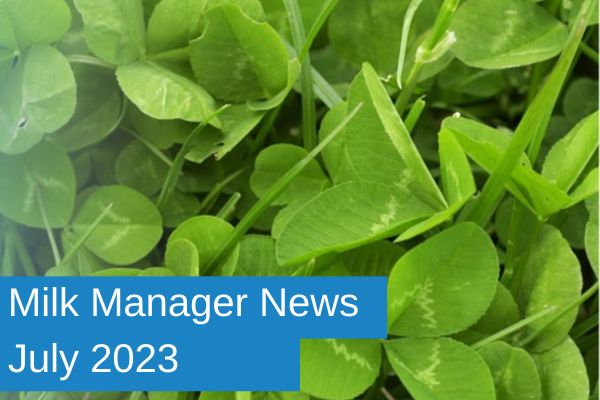MMN July 2023 – Sharing Best Practice from an Organic Dairy
11 July 2023Since fertiliser prices rocketed in 2021, the Stranraer Sustainable Group of dairy farmers (part of the FAS Connect Programme) has been assessing their use of inorganic fertilisers to reduce their reliance on them and maximise the potential of the nutrients available in their slurry. They were also keen to learn lessons from organic dairy farmers who are producing high yields of grazing and silage grass with no inorganic Nitrogen applications and so the group visited Wigtown dairy farmer Andrew Robinson, who milks 320 cows on around 700 acres. The meeting focused on the use of legume crops to grow grazing grass, grass silage and arable silage.

White Clover in Grazing Paddocks
Depending on soil fertility, structure and use of inorganic Nitrogen, grazing swards with a clover content of 30% have the ability to fix up to 180kg N/ha (the equivalent of applying 665kg/ha of 27% Nitrogen.) Spray programmes for common field weeds and high Nitrogen applications have traditionally meant that the clover content of grazing paddocks on dairy farms has been low. Reintroducing clover to a grazing sward will not only fix nitrogen but will also increase the protein content of the diet. Clover has a typical crude protein (CP) content of 27% compared to ryegrass at 17%, and provides a higher level of certain minerals (calcium, phosphorus, copper & selenium) than grass alone. When the clover content in grazing swards is very high, steps should be taken to reduce the risk of bloat.

Red Clover in Silage Swards
Red clover is an integral part of the sward composition in any organic silage system, having the potential to fix 200kg N/ha (30% red clover in the sward). This is the equivalent of applying 500kg/ha of 40% protected urea, which matches the N recommendation for a 2-cut silage system. Although not as high in CP as white clover at 14-19%, it contributes a significant amount of protein to a ration when compared to ryegrass. Weed control in silage fields is a concern for many dairy farmers but most effective spray programmes for docks will also kill out the clover. Andrew has a greater tolerance for docks as he appreciates the greater benefits that red clover brings to the sward and manages docks by preventing them from flowering and shedding seeds.

Legume Crops to Support Arable Silage and Re-seeds
To establish a reseed, Andrew undersows an arable silage crop with grass. The arable silage is typically a mix of peas and spring barley. Peas have the potential to fix up to 200kg N/ha, and again when used alongside slurry, more than meets the demands of the barley and grass crops in their Nitrogen demand. On demonstration plots in the local area run by Agrii, wholecrop peas and spring barley were grown successfully and yielded up to 31t /ha (fresh weight) with only 25t/ha separated solids applied before ploughing. An arable silage mix of peas and barley should have a CP content of around 13-16%. The dense canopy of an arable silage mix also acts to suppress weeds, with any annual weeds removed at harvest.
The farm walk proved a valuable learning experience for the group, some of whom have been trialling spring beans for wholecrop. Seeing in practice the quality and quantity of forage crops which can be grown with little or no nitrogen input has given them the confidence to try and apply some of these management practices on their own farms, to not only reduce Nitrogen use but also improve the protein content of their rations from home-grown forage.
alison.clark@sac.co.uk; 01776 702649
Sign up to the FAS newsletter
Receive updates on news, events and publications from Scotland’s Farm Advisory Service

